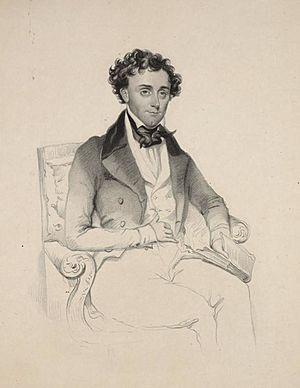Thomas D. Rice facts for kids
Quick facts for kids
Thomas D. Rice
|
|
|---|---|
 |
|
| Born | Thomas Dartmouth Rice May 20, 1808 Manhattan, New York, U.S. |
| Died | September 19, 1860 (aged 52) Brooklyn, New York, U.S. |
| Occupation | Performer, playwright |
| Nationality | American |
| Period | 1827–1860 |
| Spouse | Charlotte Bridgett Gladstone (1837-1847) |
Thomas Dartmouth Rice (born May 20, 1808 – died September 19, 1860) was an American performer. He was also a playwright, meaning he wrote plays. Rice became very famous for his "blackface" performances. In these shows, he used makeup to look like a Black person. He would then sing, dance, and speak in a way that copied African American culture.
Rice was one of the most popular minstrel show entertainers of his time. Minstrel shows were a type of American entertainment. He is often called the "father of American minstrelsy." His most famous character was "Jim Crow." This character was based on a folk trickster popular among enslaved people. Rice also made a traditional song called "Jump Jim Crow" very popular. The name "Jim Crow" later became used for laws that enforced racial segregation in the Southern United States. These laws were in place from the 1870s until 1965.
Contents
Early Life and Beginnings
Thomas Dartmouth Rice was born in Manhattan, New York. His family lived near the East River docks. He went to school for a few years. As a teenager, he started an apprenticeship with a woodcarver. However, Rice soon decided to become a performer instead.
By 1827, Rice was a traveling actor. He performed in many theaters in New York. He also traveled to stages in the Southern states and the Ohio River valley. People described him as tall and thin. Rice often shared stories about George Washington. He even claimed Washington was a friend of his father.
Becoming "Jim Crow Rice"
Rice made the Jim Crow character his main act by 1832. He traveled from theater to theater, singing his "Jim Crow Song." Soon, he became known as "Jim Crow Rice." Other performers had used blackface before him. But Rice became strongly linked to this one character.
Rice said he got the idea for Jim Crow from a Black stable groom. He claimed the groom sang and danced while working. Rice even said he bought the man's clothes to make his act more real. However, people have questioned if this story is true.
Expanding His Performances
Rice soon added more acts to his shows. One very popular routine was his "shadow dance." Rice would come on stage with a sack over his shoulder. He would then sing a song called "Me and My Shadow." As he danced, a child actor in blackface would come out of the sack. The child would copy all of Rice's moves.
Rice also played a character called the "Yankee." This was a common stage character at the time. The Yankee represented people from rural America. He usually wore a long blue coat and striped pants.
Peak Popularity and International Shows
Rice was most famous in the 1830s. At this time, blackface acts were usually part of variety shows. They were also performed between acts of other plays. Full minstrel shows became popular later.
From about 1832 to 1844, Rice was at the height of his fame. His shows often sold out. Audiences would demand many encores, asking him to perform again and again. In 1836, he took his blackface performances overseas. He appeared in London, England. People in London already knew about him and his character by 1833.
Writing and Acting in Plays
Rice performed in over 100 plays. He also wrote his own plays. In these plays, he often played characters similar to Jim Crow. For example, he played Cuff in Oh, Hush! (1833). He was Ginger Blue in Virginia Mummy (1835). He also played Bone Squash in Bone Squash Diavolo (1835).
After his success in London with Oh, Hush, Rice starred in a bigger play. It was a three-act play at the Adelphi Theatre in London. Rice also wrote and starred in a play called Otello (1844). He also played the main character in a play based on Uncle Tom's Cabin. Starting in 1854, he acted in "Tom shows." These shows were loosely based on Harriet Beecher Stowe's famous book.
"The Virginny Cupids" was a very popular musical show. It was based on a song called "Coal Black Rose." In this play, Rice played Cuff, who was the boss of the bootblacks. Cuff wins the girl, Rose, away from another character named Sambo Johnson.
Rice's performances sometimes included messages about society. In 1832, he sang a song that warned white people not to bother him. He also sang about how Black and white people could be like brothers.
Later Life and Death
Thomas Rice married Charlotte Bridgett Gladstone in England in 1837. She passed away in 1848. They had four children together. Their names were Frances Gwynne Gladstone Rice, John Joy, Mary Gwynne, and Elizabeth Mary Rice. Sadly, John Joy and Mary Gwynne died as babies.
Rice enjoyed showing off his wealth. When he came back from London, he wore a blue coat with gold coins as buttons. His vest had a diamond on each gold button.
Around 1840, Rice began to suffer from an illness. This illness made it hard for him to speak and move. It eventually led to his death on September 19, 1860. He was buried at Green-Wood Cemetery in Brooklyn, New York.
See also
 In Spanish: Thomas Dartmouth Rice para niños
In Spanish: Thomas Dartmouth Rice para niños

